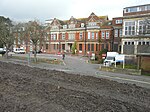South Kent College
Ashford, KentDover DistrictFurther education colleges in KentHigher education colleges in England
South Kent College (SKC) was a college of further and higher education in southeast England. The main campus was in Folkestone, with satellites in Dover and at several sites in Ashford. Following a KPMG report in 2008 that recommended a merger, in April 2010 SKC joined West Kent College to form South & West Kent College, trading as K College.
Excerpt from the Wikipedia article South Kent College (License: CC BY-SA 3.0, Authors).South Kent College
Shorncliffe Road, Folkestone and Hythe District Lynwood
Geographical coordinates (GPS) Address Nearby Places Show on map
Geographical coordinates (GPS)
| Latitude | Longitude |
|---|---|
| N 51.081666666667 ° | E 1.1661111111111 ° |
Address
Folkestone College
Shorncliffe Road
CT20 2TZ Folkestone and Hythe District, Lynwood
England, United Kingdom
Open on Google Maps








